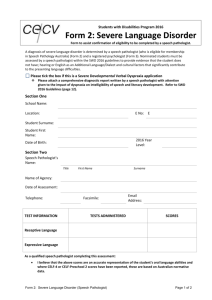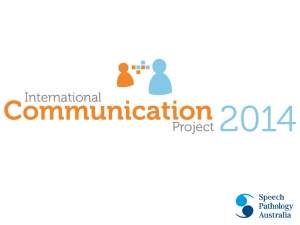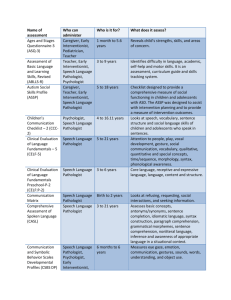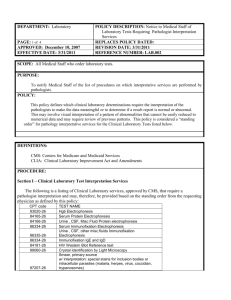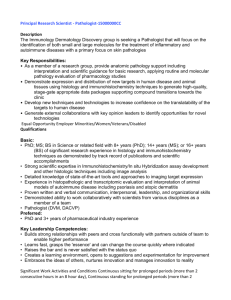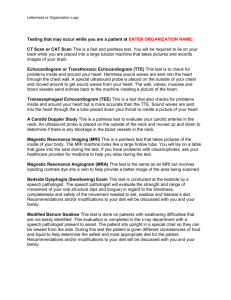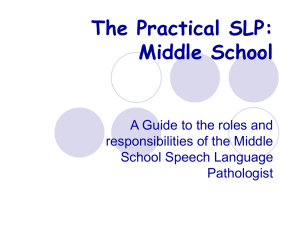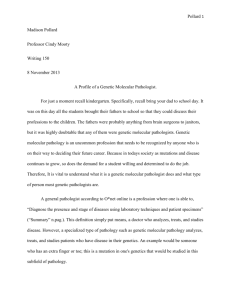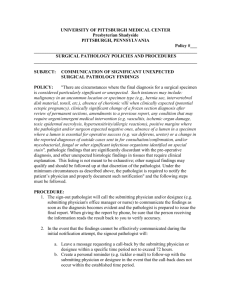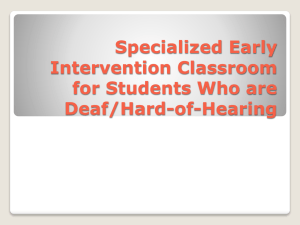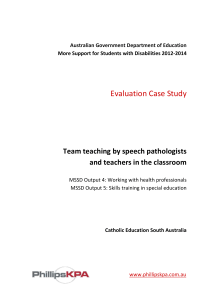Name of assessment Who can administer Who is it for? What does it
advertisement
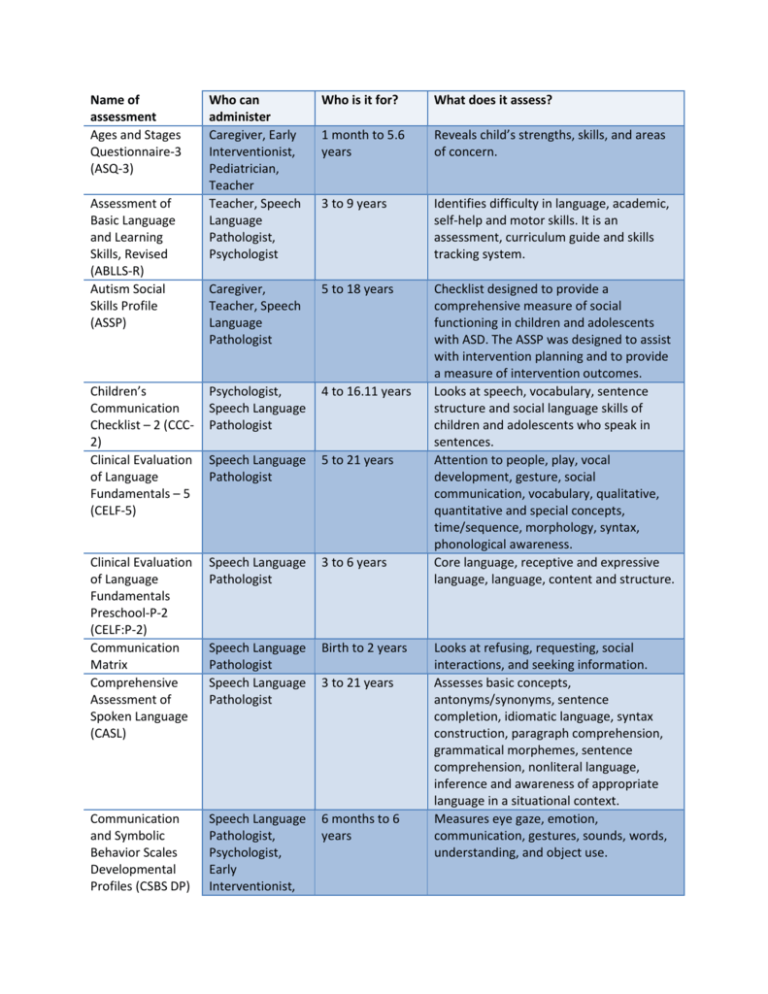
Name of assessment Ages and Stages Questionnaire-3 (ASQ-3) Who can administer Caregiver, Early Interventionist, Pediatrician, Teacher Teacher, Speech Language Pathologist, Psychologist Who is it for? What does it assess? 1 month to 5.6 years Reveals child’s strengths, skills, and areas of concern. 3 to 9 years Identifies difficulty in language, academic, self-help and motor skills. It is an assessment, curriculum guide and skills tracking system. Caregiver, Teacher, Speech Language Pathologist 5 to 18 years Children’s Communication Checklist – 2 (CCC2) Clinical Evaluation of Language Fundamentals – 5 (CELF-5) Psychologist, Speech Language Pathologist 4 to 16.11 years Speech Language Pathologist 5 to 21 years Clinical Evaluation of Language Fundamentals Preschool-P-2 (CELF:P-2) Communication Matrix Comprehensive Assessment of Spoken Language (CASL) Speech Language Pathologist 3 to 6 years Checklist designed to provide a comprehensive measure of social functioning in children and adolescents with ASD. The ASSP was designed to assist with intervention planning and to provide a measure of intervention outcomes. Looks at speech, vocabulary, sentence structure and social language skills of children and adolescents who speak in sentences. Attention to people, play, vocal development, gesture, social communication, vocabulary, qualitative, quantitative and special concepts, time/sequence, morphology, syntax, phonological awareness. Core language, receptive and expressive language, language, content and structure. Speech Language Pathologist Speech Language Pathologist Birth to 2 years Communication and Symbolic Behavior Scales Developmental Profiles (CSBS DP) Speech Language Pathologist, Psychologist, Early Interventionist, 6 months to 6 years Assessment of Basic Language and Learning Skills, Revised (ABLLS-R) Autism Social Skills Profile (ASSP) 3 to 21 years Looks at refusing, requesting, social interactions, and seeking information. Assesses basic concepts, antonyms/synonyms, sentence completion, idiomatic language, syntax construction, paragraph comprehension, grammatical morphemes, sentence comprehension, nonliteral language, inference and awareness of appropriate language in a situational context. Measures eye gaze, emotion, communication, gestures, sounds, words, understanding, and object use. Pediatrician Psychologist 6 to 89 years Evaluating Acquired Skills In Communication-3 (EASIC-3) Expressive One Word Picture Vocabulary Test – 4th Edition (EOWPVT-4) Expressive Vocabulary Test, 2nd Edition (EVT-2) Functional Communication Profile- Revised (FCP-R) Speech Language Pathologist 3 months to 6.3 years Psychologist, Speech Language Pathologist 2 to 80 years Psychologist, Speech Language Pathologist Speech Language Pathologist, Teacher 2.6 to 80 years Oral and Written Language Scales (OWLS) Speech Language Pathologist, Psychologist Peabody Picture Vocabulary Test, 4th Edition (PPVT4) Preschool Language Scale-5 (PLS-5) Pragmatic Language Observation Scale Speech Language Pathologist, Psychologist 3 to 21 years for listening comprehension and oral expression; 5 to 21 years for written expression 2.6 to 80 years Comprehensive Test of Nonverbal Intelligence (CTONI) Pragmatic Language Skills Inventory 3 years to adult Speech Language Pathologist Birth to 7.11 years Speech Language Pathologist, Teacher, Psychologist Teacher, Caregiver 8 to 17.11 years 5 to 12.11 years Uses nonverbal formats to measure general intelligence of children and adults whose performance on traditional tests might be adversely affected by subtle or overt impairments involving language or motor abilities. Assesses the areas of prelinguistic skills, semantics, morphology, syntax and pragmatics. Tests an individual’s ability to name, with one word, objects, actions and concepts when presented with color illustrations. Can be used to assess and document vocabulary development. Assesses expressive vocabulary with a test that requires no reading or writing. Evaluates sensory-motor skills, attentiveness, receptive and expressive language, pragmatic/social language, speech, voice, oral fluency and nonverbal communication. Assesses vocabulary, grammar, pragmatic structures and higher order thinking; provides an individual’s ability to understand and produce connected language, both spoken and written. Measures understanding of the spoken word to assess vocabulary acquisition. Targets interaction, attention, vocal/gestural behaviors and different levels of play. Assesses student’s daily classroom spoken language behaviors. Assesses children’s pragmatic language abilities in three subscales: Personal Interaction Skills, Social Interaction Skills and Classroom Interaction Skills. Psychoeducational Teacher, Speech Profile-Revised Language (PEP-3) Pathologist, Psychologist 6 months to 7 years ReceptiveExpressive Emergent Language Test-3 (REEL-3) Receptive One Word Picture Vocabulary Test4th Edition (ROWPVT-4) The Rosetti InfantToddler Language Scale Social Language Development Test Elementary Speech Language Pathologist Birth to 3 years Speech Language Pathologist, Psychologist 2 to 80 years Tests an individual’s ability to match a spoken word with an image of an object, action or concept. Can be used to assess and document vocabulary development. Speech Language Pathologist, Early Interventionist Speech Language Pathologist, Psychologist Birth to 3 years Social Responsiveness Scale (SRS) Teacher, Caregiver, Speech Language Pathologist 4 to 18 years Test of AidedCommunication Symbol Preference (TASP) Speech Language Pathologist, Psychologist Children and adults who can point to pictures Test of Early Communication and Emerging Language (TECEL) Teacher, Psychologist, Speech Language Pathologist 2 weeks to 24 months TEACCH Transition Assessment Profile (TTAP) Teacher, Psychologist, Caregiver, Speech Language Pathologist Speech Language 3rd through 12th grades Interaction attachment, pragmatics, gesture, play, language and comprehension. Focuses on language-based skills of social interpretation and interaction with friends; assesses student’s language-based responses to portrayed, peer to peer situations. Measures severity of ASD in natural social settings; assesses social awareness, social information processing, capacity for reciprocal social communication, social anxiety/avoidance and preoccupations and traits. Provides a starting point for designing or selecting an appropriate AAC device page set. Uses results to design communication boards and establish appropriate AAC intervention goals and strategies targeting symbolic and syntactic development. (Formerly known as the Non Speech Test) Used to assess and chart communication and language strengths and weaknesses and design intervention plans and to make estimates about future language development. Evaluates six major functional skills areas: vocational skills, vocational behavior, independent functioning, leisure skills, functional communication and interpersonal behavior. Assesses higher level language function in Test of Language 6 to 11 years Level 1: 5 to 9 Charts uneven and idiosyncratic development, emerging skills and used to assist in programming. Determines strengths and weaknesses, established development/adaptive levels. Receptive and expressive language and inventory of vocabulary words. CompetenceExpanded Pathologist, Psychologist years; Level 2: 10 to 18 years 8 to 17.11 years Test of Language Development: Intermediate-4 (TOLD: I-4) Test of Language Development: Primary-4 (TOLD:P-4) Speech Language Pathologist Speech Language Pathologist 6 to 19 years Test of Pragmatic Language (TOPL-2) Test of Problem Solving 2Adolescent (TOPS2) Test of Problem Solving 2Elementary (TOPS2) Verbal Behavior Milestones Assessment and Placement Program (VBMAPP) Speech Language Pathologist Speech Language Pathologist 6 to 19 years Speech Language Pathologist 6 to 12 years Making inferences, sequencing, negative questions, problem solving, predicting, determining causes. Teacher, Speech Language Pathologist, Psychologist 18 months to adult Criterion reference tool, curriculum guide and skill tracking system. Serves as a guide for development of individualized language, social skills and learning. 12 to 18 years ambiguous sentences, listening comprehension, making inference, oral expression, figurative language, memory. Sentence combining, picture vocabulary, word ordering, relational vocabulary, morphological comprehension and multiple meanings. Picture, relational and oral vocabulary, syntactic understanding, sentence imitation, morphological completion, word discrimination, word analysis and word articulation. Physical setting, audience, topic, purpose, visual-gestural cues, abstraction. Making inferences, determining solutions, problem solving, interpreting, perspective and transferring insights.
